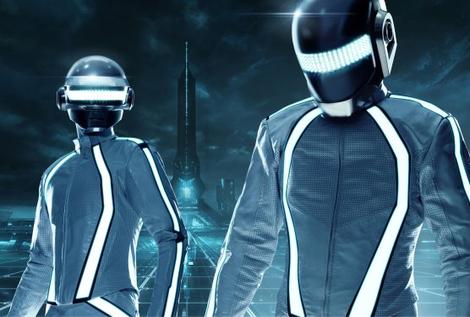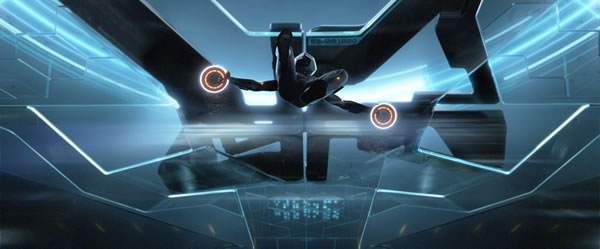Why you can trust GamesRadar+
Just a few seconds in, you can feel it. This isn’t going to one of those movies that gives 3D a bad name.
The camera swoops down out of the night sky, rushes through city streets and glides up to the front door of Kevin Flynn’s house, where we see the hacker-turned-cyberman (Jeff Bridges) telling bedtime stories to his seven-year-old son Sam.
It’s the night Flynn will suddenly disappear forever. For the first time since Avatar, Tron Legacy uses the technology to make us experience something new and special again.
For now, debut director Joe Kosinksi wisely soft-pedals the stereoscopic dazzle. He barely needs it. Even in the real world, Tron Legacy is just gorgeous to gawp at.
Hypnotic shots of Sam slaloming a Ducati motorbike between cars on a freeway at night take us to Encom, the corporation once headed by Kevin.
We’ve flashed forward 20 years: Sam (Garrett Hedlund) is now a smart, stubborn biker who refuses to take over the family company.
After a spectacularly ludicrous scene in which Sam hacks the Encom mainframe before free-fall parachuting off the top of the building like Ethan Hunt, it’s a matter of minutes before we’re blasted into cyberspace.
A mysterious message from Flynn’s Arcade. A laser beam. We’re there. Back in The Grid. And things have changed since 1982.
Upgraded in breathtaking style by Kosinski’s team, this stormy, apocalyptic city is a fearful, magnificent world of dark space, reflective surface and searing light. It’s stunning, seductive and uniquely Tron .
Although curiously, unavoidable echoes of Blade Runner seem to lie everywhere: otherworldly women, elevators to the heavens, charred skies; even one character’s haircut is pure Rutger Hauer.
Not that we’re left much time to stare. For the first 20 minutes on The Grid, Legacy ’s velocity is thrilling: Sam is abducted, suited in neon-ribbed body armour, loaded into a gladiatorial stadium and hurled into a disc fight.
Which is like a lethal game of air hockey (just one of Tron Legacy's classic-arcade game nods), as black-suited Capoeira-style foes send electric frisbees ricocheting around a glassy area.
But the new-look light-bike battle royale is something else.
Leaving behind mesmerising liquid ribbons of light as they surge around a multi-level arena, the cycles are beyond cool. What’s more, the human actors all exist seamlessly in this CG environment.
This is an architect’s mind at work – Kosinski’s background – and he proves himself a highly imaginative level designer.
Meanwhile, Daft Punk’s score paints its own sombre, synthy soundscapes, pumping vibe and life into cold, hard surfaces of Tron ’s world.
Next: Tron: Legacy review conclusion [page-break]

It’s a while before we’re given a second to figure out what’s going on. And that’s when the gloss on this brave new world starts to crack.
Kevin Flynn is a fugitive trapped inside the digital world by his own avatar CLU, an evil doppelganger who now controls The Grid.
Unfamiliar with the original movie? You’re going to feel a little lost.
Even hardcore Tron-heads will be scratching scalp at certain points. Best thing to do? Just don’t think too hard about any of it.
Apparently having moved into the room visited by Bowman at the end of 2001: A Space Odyssey , Kevin claims the ISOs – the miraculous nano-life that magically, organically created inside this computer world – hold the key to all humanity. Not sure how. Not sure why. Not sure we care.
The Holocaust, evil doppelgangers, mad scientists, God complexes, a paradise lost... Kosinski touches on more themes than he ever knows what to do with.
There’s very little story here at all, and Bridges is forced to chug through several scenes of backstory and exposition in the middle portion of the film, which cost Tron its pace, drive and urgency.
Happily, Lost writers Edward Kitsis and Adam Horowitz just about keep their script anchored to its characters as much as its electric dreams, though it’s often touch and go.
Previously best known for his breakout role as Brad Pitt’s young brother in Troy, Hedlund proves a solid lead, despite wincing through emotional scenes with Bridges.
Olivia Wilde’s playful warrior sprite Quorra also manages not to be out-acted by her fetish wardrobe, bringing a pleasing mix of innocence and steeliness to the role.
Fittingly, the most debate-worthy performance belongs to a computer program.
Conjured by a Jeff Bridges body double and Benjamin Button ’s Oscar-winning motion-capture wizards, CLU is undoubtedly a remarkable achievement.
Never do you really believe you’re watching the young Jeff but – perhaps due to the Uncanny Valley effect – he a weirdly disturbing, compulsive creature.
You could argue he’s more convincing than Michael Sheen, whose camp-daddy Ziggy Stardust bartender sashays between flamboyant and ridiculous with every passing second.
The attempt to inject much-needed levity is laudable, but… he isn’t funny. Almost inevitably, the real humanity comes from the real Bridges.
Packing his customary payload of gravitas and wry humour (“You’re messing with my Zen thing, man!”), he gets the grandiose finale his character deserves.
Although by the finish of this alluring but flawed adventure, you’ll still be left with plenty of questions. Not least, why was there only one light-cycle battle?
More info
| Genre | "Action" |
| Description | Launching alongside the second TRON film is this universal iPad and iPhone app, which includes light cycle race missions and on-rails shooting segments where you blast enemies from a Recognizer. |
| Platform | "iPhone","iPad" |
| Release date | 1 January 1970 (US), 1 January 1970 (UK) |



